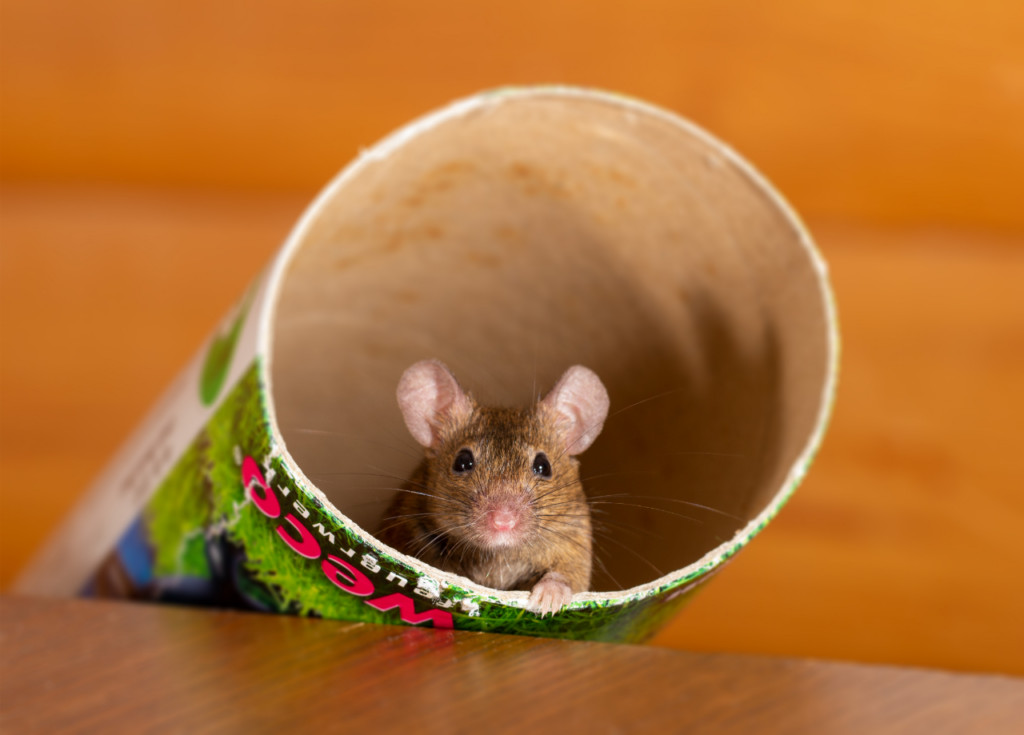Dealing with mice in your travel trailer? SIXT.VN offers expert tips and solutions to eliminate these unwanted guests and prevent future infestations, ensuring a pest-free and enjoyable Vietnam travel experience. Discover effective strategies, from natural repellents to professional services, and learn how to maintain a clean and secure RV during your adventures. Explore SIXT.VN for reliable travel advice and services for your Vietnam getaway including airport transfers, hotel bookings, day tours.
1. Understanding the Problem: Why Are Mice in My Travel Trailer?
Mice seeking shelter, food, and warmth often find travel trailers an ideal habitat, especially during colder months. Recognizing the reasons behind their presence is the first step in effective mouse control.
1.1. What Attracts Mice to Travel Trailers?
Travel trailers offer several attractions for mice:
- Food Sources: Crumbs, improperly stored food, and even pet food can attract mice.
- Shelter: Small cracks and crevices provide easy access and safe nesting spots.
- Warmth: Insulation in RVs provides a cozy environment, particularly in colder climates.
- Water: Leaky pipes or standing water can serve as a water source for mice.
1.2. How Do Mice Enter Travel Trailers?
Mice can squeeze through incredibly small openings. Common entry points include:
- Gaps in Wiring: Openings around electrical wiring and plumbing.
- Unsealed Cracks: Cracks in the walls, floors, or roof.
- Openings Around Pipes: Spaces where pipes enter or exit the trailer.
- Storage Compartments: Unsealed storage areas that provide direct access.
1.3. What Are the Signs of a Mouse Infestation?
Identifying a mouse problem early can prevent significant damage. Look for these signs:
- Droppings: Small, dark pellets are a clear indicator of mice.
- Gnaw Marks: Damaged food packaging, furniture, or wiring.
- Nesting Materials: Shredded paper, fabric, or insulation in hidden areas.
- Musty Odor: A distinctive, stale smell indicating the presence of mice.
- Scratching Noises: Sounds of movement within the walls or floors, especially at night.
- Sightings: Spotting a mouse is a definitive sign of infestation.
According to research from the National Pest Management Association (NPMA), in 2023, early detection and prevention are key to managing pest infestations in recreational vehicles.
2. Immediate Steps: What to Do When You Find Mice
Discovering mice in your travel trailer requires immediate action. Here’s how to respond effectively.
2.1. Initial Assessment: Gauge the Severity of the Infestation
Determine the extent of the problem. Are there only a few signs, or is the infestation widespread? This will help you choose the right approach.
2.2. Cleaning: Remove Food Sources and Droppings
- Thorough Cleaning: Clean all surfaces to remove food crumbs and spills.
- Sanitize: Disinfect areas where droppings were found to eliminate potential health hazards.
- Proper Storage: Store all food in airtight containers to prevent access.
According to the Centers for Disease Control and Prevention (CDC), in 2022, proper sanitation and food storage are essential in preventing the spread of diseases carried by rodents.
2.3. Sealing Entry Points: Prevent Further Access
- Inspect: Identify and seal any entry points, no matter how small.
- Use Appropriate Materials: Steel wool, caulk, and metal flashing are effective for sealing gaps.
- Check Regularly: Periodically inspect and maintain seals to ensure they remain intact.
 Mouse hiding in a RV
Mouse hiding in a RV
3. Effective Removal Methods: How to Get Rid of Mice
Choosing the right removal method is crucial. Here’s a look at both lethal and non-lethal options.
3.1. Lethal Methods: Traps and Poisons
Lethal methods can quickly reduce the mouse population but require careful handling.
3.1.1. Snap Traps
- How They Work: Snap traps are baited and spring shut, killing the mouse instantly.
- Bait Options: Cheese, peanut butter, or small pieces of meat work well.
- Placement: Place traps in areas where mice are active, such as along walls or near food sources.
3.1.2. Glue Traps
- How They Work: Mice get stuck to the sticky surface and are unable to escape.
- Considerations: These traps can be inhumane, as mice may suffer for extended periods before dying.
- Monitoring: Check traps regularly to remove captured mice.
3.1.3. Rodenticides (Poisons)
- How They Work: Mice consume poisoned bait, leading to their death.
- Risks: Poison can be dangerous to pets and children.
- Safety: Use only in areas inaccessible to non-target animals and humans.
According to the Environmental Protection Agency (EPA), in 2021, rodenticides should be used with extreme caution due to the potential for accidental poisoning of pets and wildlife.
3.2. Non-Lethal Methods: Catch and Release
Non-lethal methods allow you to remove mice without killing them.
3.2.1. Live Traps
- How They Work: Mice enter a trap baited with food and are unable to escape.
- Bait Options: Peanut butter, nuts, or seeds work well.
- Release: Release mice at least 100 feet away from your RV to prevent them from returning.
3.2.2. Electronic Traps
- How They Work: Electronic traps deliver a high-voltage shock, killing the mouse instantly and humanely.
- Advantages: No need to handle dead mice, easy to empty.
- Maintenance: Requires battery power and regular cleaning.
3.2.3. Natural Repellents
- Peppermint Oil: Mice dislike the strong scent of peppermint.
- Application: Soak cotton balls in peppermint oil and place them in strategic areas.
- Bay Leaves: Place bay leaves in cupboards and drawers to deter mice.
- Other Scents: Ammonia, vinegar, and cloves can also act as repellents.
According to research from the University of Nebraska-Lincoln, in 2020, peppermint oil and other natural repellents can be effective in deterring mice, but may require frequent reapplication to maintain their potency.
3.3. Professional Pest Control: When to Call an Expert
If the infestation is severe or you are uncomfortable handling it yourself, professional pest control is a wise choice.
- Expert Assessment: Professionals can identify the extent of the infestation and the best course of action.
- Safe and Effective Treatments: They have access to treatments not available to the public.
- Prevention Strategies: Pest control services can offer advice on preventing future infestations.
4. Long-Term Prevention: Keeping Mice Out for Good
Preventing mice from returning requires ongoing vigilance and maintenance.
4.1. Maintaining a Clean Environment
- Regular Cleaning: Sweep, vacuum, and mop regularly to remove food debris.
- Food Storage: Store all food in airtight containers.
- Waste Management: Dispose of garbage regularly and keep bins tightly sealed.
4.2. Sealing Entry Points
- Routine Inspections: Regularly check for new cracks or openings.
- Proper Sealing: Seal all entry points with durable materials like steel wool and caulk.
- Underbelly Inspection: Inspect and seal the underbelly of the RV, as mice can enter from below.
4.3. Using Repellents Regularly
- Strategic Placement: Place repellents near potential entry points and nesting areas.
- Regular Replacement: Replace repellents regularly to maintain their effectiveness.
- Combination Approach: Use a combination of natural and commercial repellents for best results.
4.4. Landscape Management
- Trim Vegetation: Keep grass and shrubs trimmed away from the RV to reduce hiding spots for mice.
- Remove Debris: Clear away piles of wood, leaves, and other debris that can provide shelter for mice.
- Avoid Feeding Wildlife: Do not leave out food that could attract mice and other rodents.
5. Additional Tips for RV Owners: Specific Prevention Strategies
Here are some additional strategies tailored to RV owners.
5.1. Winterizing Your RV
- Seal Gaps: Seal all gaps and openings before winterizing your RV.
- Remove Food: Remove all food from the RV to eliminate potential attractions.
- Use Repellents: Place repellents throughout the RV to deter mice.
5.2. Storing Your RV
- Cover the RV: Use a RV cover to protect it from the elements and prevent mice from entering.
- Elevate the RV: Elevate the RV on blocks to reduce access for mice.
- Check Regularly: Check the RV periodically for signs of infestation.
5.3. Travel Tips
- Inspect Campsites: Inspect campsites for signs of rodent activity before parking your RV.
- Avoid Problem Areas: Avoid parking near garbage bins or overgrown vegetation.
- Seal Food: Keep all food sealed while traveling to prevent attracting mice.
6. DIY Mouse Trap: Building a Simple Trap
Here’s how to build a simple, non-lethal mouse trap using common household items.
6.1. Materials You’ll Need
- A large bucket
- A cardboard tube or paper towel roll
- Peanut butter
- A ruler or stick
- Tape
6.2. Step-by-Step Instructions
- Prepare the Bucket: Ensure the bucket is clean and empty.
- Apply Bait: Spread peanut butter at one end of the cardboard tube.
- Position the Tube: Place the baited end of the tube over the edge of the bucket, with the majority of the tube extending over the bucket.
- Create a Ramp: Use a ruler or stick to create a ramp leading up to the edge of the bucket, making it easier for the mouse to reach the tube. Secure the ramp with tape if necessary.
- Set the Trap: Place the trap in an area where you’ve noticed mouse activity.
- Check Regularly: Check the trap daily. If you catch a mouse, release it far away from your property.
This DIY trap is a simple and humane way to catch mice without harming them.
7. Real-Life Scenarios: Success Stories and Lessons Learned
Sharing real-life experiences can provide valuable insights into dealing with mice in travel trailers.
7.1. Case Study 1: Preventing Infestation in a Stored RV
Scenario: An RV owner stored their travel trailer for the winter and took preventative measures to avoid mouse infestation.
Actions Taken:
- Thoroughly cleaned the RV, removing all food items.
- Sealed all visible entry points with steel wool and caulk.
- Placed cotton balls soaked in peppermint oil throughout the RV.
- Covered the RV with a protective cover.
Results: The RV remained mouse-free throughout the winter.
7.2. Case Study 2: Dealing with an Existing Infestation
Scenario: An RV owner discovered a mouse infestation upon opening their travel trailer for the summer.
Actions Taken:
- Set snap traps baited with peanut butter in areas of high activity.
- Sealed all entry points after removing the mice.
- Cleaned and disinfected all affected areas.
Results: The traps successfully eliminated the mice, and sealing the entry points prevented re-infestation.
7.3. Lessons Learned
- Prevention is Key: Taking preventative measures before storing an RV is more effective than dealing with an existing infestation.
- Persistence Pays Off: Regularly checking and maintaining preventative measures is crucial.
- Professional Help is Valuable: When faced with a severe infestation, consulting a pest control professional can save time and ensure effective treatment.
8. The Importance of Proper Sanitation
Maintaining a clean environment is crucial in preventing mouse infestations.
8.1. Regular Cleaning Practices
- Sweep and Vacuum Regularly: Clean floors, carpets, and upholstery to remove food crumbs and debris.
- Mop Hard Surfaces: Clean kitchen and bathroom surfaces to remove spills and stains.
- Clean Appliances: Regularly clean inside the refrigerator, microwave, and oven to prevent food buildup.
8.2. Food Storage Guidelines
- Airtight Containers: Store all food items in airtight containers to prevent mice from accessing them.
- Elevated Storage: Store food containers on shelves or in cabinets to keep them off the floor.
- Avoid Open Containers: Do not leave food items in open containers on countertops or tables.
8.3. Waste Management Strategies
- Tightly Sealed Bins: Use garbage bins with tightly sealed lids to prevent mice from accessing waste.
- Regular Disposal: Dispose of garbage regularly to prevent buildup.
- Outdoor Storage: Store garbage bins away from the RV to reduce attraction for mice.
9. Natural vs. Chemical Solutions: Weighing the Options
When dealing with mice, it’s essential to consider the pros and cons of natural and chemical solutions.
9.1. Natural Solutions
- Pros:
- Environmentally friendly.
- Safe for pets and children.
- Cost-effective.
- Cons:
- May not be as effective for severe infestations.
- Requires regular reapplication.
- Effectiveness can vary.
9.2. Chemical Solutions
- Pros:
- Highly effective for eliminating mice.
- Provides quick results.
- Long-lasting.
- Cons:
- Can be harmful to pets and children.
- Potential environmental impact.
- May require professional handling.
9.3. Making the Right Choice
- Assess the Infestation: Determine the severity of the infestation before choosing a solution.
- Consider Safety: Prioritize the safety of pets, children, and the environment.
- Combine Approaches: Use a combination of natural and chemical solutions for best results.
10. Addressing Common Concerns
Here are answers to some frequently asked questions about dealing with mice in travel trailers.
10.1. Will Insurance Cover Mouse Damage?
- Coverage Varies: Check your insurance policy to determine if mouse damage is covered.
- Preventative Measures: Insurance may not cover damage resulting from lack of preventative maintenance.
- Documentation: Document all damage and expenses for insurance claims.
10.2. How to Find Mouse Entry Points?
- Visual Inspection: Carefully inspect all areas of the RV for cracks, gaps, and openings.
- Flashlight: Use a flashlight to illuminate dark and hard-to-reach areas.
- Professional Help: Consider hiring a pest control professional to identify entry points.
10.3. What Are the Health Risks Associated with Mice?
- Disease Transmission: Mice can transmit diseases through their droppings, urine, and saliva.
- Allergies: Mouse allergens can trigger allergic reactions in some people.
- Contamination: Mice can contaminate food and surfaces, leading to illness.
10.4. How Often Should I Check for Mice?
- Regularly: Check for signs of mice at least once a month.
- Seasonal Changes: Increase frequency during colder months when mice seek shelter indoors.
- After Storage: Check thoroughly after storing the RV for extended periods.
11. How SIXT.VN Can Enhance Your Vietnam Travel Experience
While managing pests in your RV is essential, so is planning a smooth and enjoyable trip. SIXT.VN offers a range of services to make your Vietnam adventure unforgettable.
11.1. Tailored Travel Advice
SIXT.VN provides expert travel advice tailored to your preferences, helping you create the perfect itinerary for exploring Vietnam.
11.2. Convenient Airport Transfers
Start your journey stress-free with SIXT.VN’s reliable airport transfer services, ensuring a comfortable and timely arrival at your destination.
Address: 260 Cau Giay, Hanoi, Vietnam
Hotline/Whatsapp: +84 986 244 358
11.3. Hotel Booking Assistance
Find the best accommodations to suit your needs and budget with SIXT.VN’s hotel booking assistance, offering a variety of options for a comfortable stay.
11.4. Exciting Day Tours
Discover the beauty and culture of Vietnam with SIXT.VN’s exciting day tours, designed to showcase the country’s most captivating destinations.
11.5. Comprehensive Support
From travel advice to booking assistance, SIXT.VN offers comprehensive support to ensure a seamless and enjoyable travel experience in Vietnam.
12. Conclusion
Dealing with mice in a travel trailer requires a combination of prevention, immediate action, and ongoing maintenance. By understanding what attracts mice, sealing entry points, and employing effective removal methods, you can keep your RV mouse-free. Remember, SIXT.VN is here to enhance your Vietnam travel experience with expert advice and convenient services.
Are you ready to explore Vietnam without worrying about pests? Contact SIXT.VN today to learn more about our services and start planning your dream trip.
FAQ Section
1. What is the best way to get rid of mice in a travel trailer?
The best method involves a combination of sealing entry points, removing food sources, and using traps (both lethal and non-lethal) or repellents. Regular cleaning and maintenance are also crucial.
2. How do I seal entry points to prevent mice from entering my RV?
Use steel wool, caulk, or metal flashing to seal gaps around pipes, wiring, and cracks in walls, floors, and the roof. Regularly inspect and maintain these seals.
3. Are natural repellents effective against mice in travel trailers?
Yes, natural repellents like peppermint oil, bay leaves, and other strong scents can deter mice. However, they may require frequent reapplication to maintain their effectiveness.
4. What are the signs of a mouse infestation in a travel trailer?
Signs include droppings, gnaw marks, nesting materials, a musty odor, scratching noises, and actual sightings of mice.
5. Is it safe to use poison to get rid of mice in an RV?
Using poison can be risky due to the potential harm to pets, children, and wildlife. If used, it should be placed in areas inaccessible to non-target animals and humans.
6. How far away should I release a mouse after catching it in a live trap?
Release mice at least 100 feet away from your RV to prevent them from returning.
7. Can mice cause significant damage to a travel trailer?
Yes, mice can cause damage by gnawing on wiring, furniture, and other materials. They can also contaminate food and surfaces with their droppings and urine.
8. What should I do if I suspect a severe mouse infestation in my RV?
If you suspect a severe infestation, consider hiring a professional pest control service to assess the problem and provide effective treatment.
9. How can SIXT.VN help with my travel plans in Vietnam?
SIXT.VN offers tailored travel advice, convenient airport transfers, hotel booking assistance, exciting day tours, and comprehensive support to ensure a seamless and enjoyable travel experience in Vietnam.
10. What are some travel tips to prevent attracting mice to my RV while camping?
Inspect campsites for rodent activity before parking, avoid parking near garbage bins or overgrown vegetation, and keep all food sealed while traveling to prevent attracting mice.
Internal Links
Hanoi Airport Transfer: Your Gateway to a Seamless Arrival
Unveiling Hanoi’s Hidden Gems: A Journey Beyond the Tourist Trail





